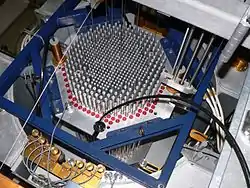| CROCUS | |
|---|---|
 CROCUS' core | |
| Operating Institution | École Polytechnique Fédérale de Lausanne |
| Coordinates | 46°31′16″N 6°34′13″E / 46.521238°N 6.570361°E |
| Power | 100 W[1] (thermal) |
| Construction and Upkeep | |
| Construction Began | January 1, 1970[1] |
| First Criticality | July 13, 1983[1] |
| Staff | 8[1] |
| Operators | 2[1] |
| Technical Specifications | |
| Max Thermal Flux | 7.5×108 cm-2s-1[1] |
| Max Fast Flux | 1.75×109 cm-2s-1 [1] |
| Cooling | light water[1] |
| Neutron Moderator | light water[1] |
| Neutron Reflector | light water[1] |
| Control Rods | 2[1] |
CROCUS is a research reactor at École Polytechnique Fédérale de Lausanne, a research institute and university in Lausanne, Switzerland.
The uranium nuclear reactor core is in an aluminium container that measures 130 centimetres (51 in) across with 1.2-centimetre (0.47 in)-thick walls. The aluminum vessel is filled with demineralized light water to serve as both a neutron moderator and a neutron reflector.[2]
Power output is controlled either by adjusting the water level in the reactor—with a ±0.1-millimetre (0.0039 in) level of control, or with the adjustment of two boron carbide (B4C) control rods—with a ±1-millimetre (0.039 in) level of finesse. The reactor has six separate safety systems: two cadmium shields and four storage tanks, any of which can shut down the reaction in less than a second.[2]
CROCUS has a license to produce 100 watts (0.13 hp) or a neutron flux of ~2.5 × 109 cm-2s-1 at the core's center.[2]
References
- 1 2 3 4 5 6 7 8 9 10 11 "IAEA Research Reactors Database (RRDB)". International Atomic Energy Agency. Archived from the original on 27 December 2021. Retrieved 27 December 2021.
- 1 2 3 "CROCUS Reactor — LRS". École Polytechnique Fédérale de Lausanne. Archived from the original on 12 December 2018. Retrieved 12 December 2018.
See also
 Media related to CROCUS at Wikimedia Commons
Media related to CROCUS at Wikimedia Commons